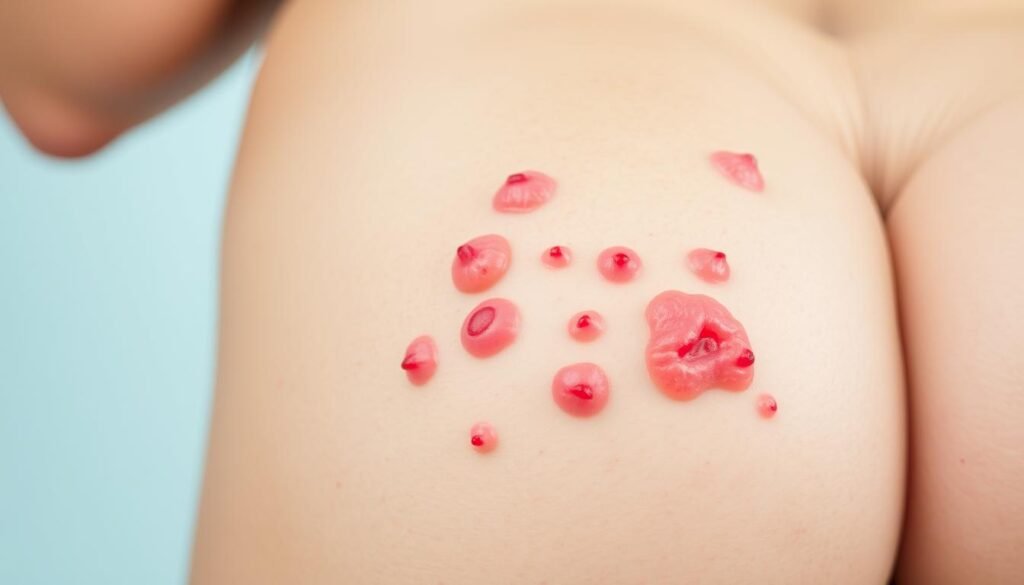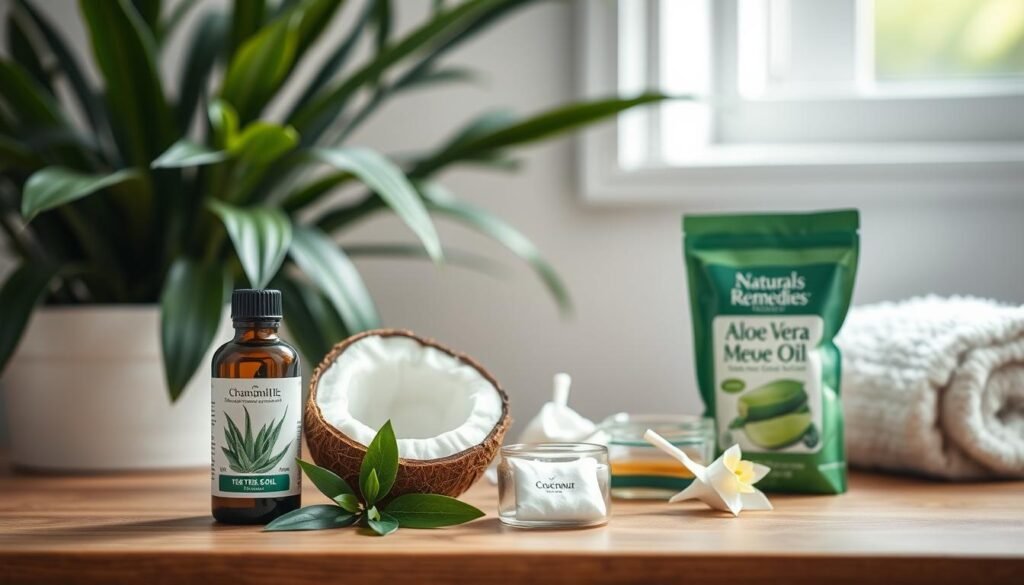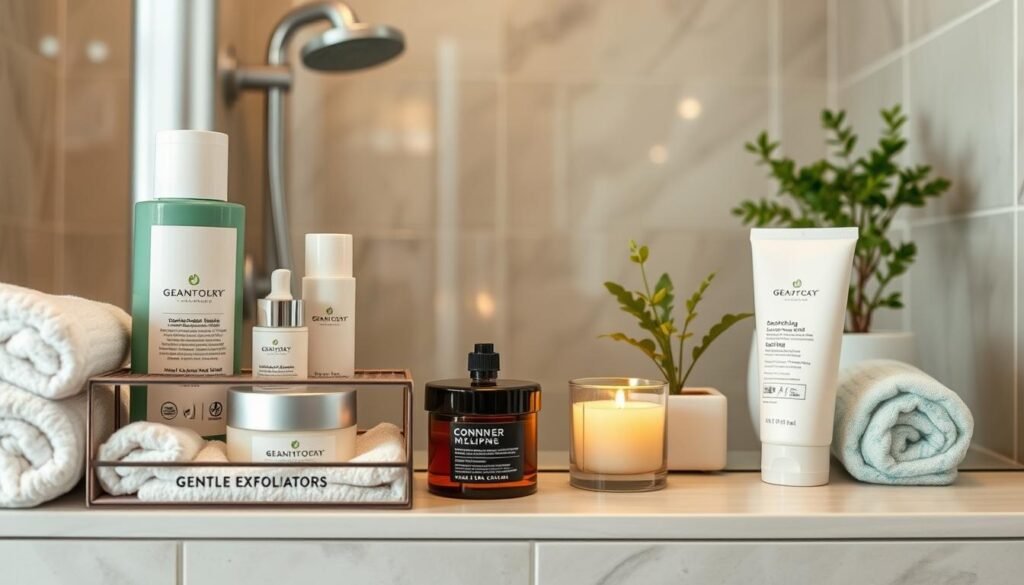Did you know a huge 40-80% of young people and around 40% of adults deal with keratosis pilaris? This skin issue often looks a lot like acne. It sheds light on a big problem in skin care, especially with conditions like folliculitis on the buttocks. This condition makes red bumps and causes discomfort. Knowing about folliculitis is key to treating and stopping it.
This piece offers an in-depth guide to tackling buttock folliculitis. It covers everything from what causes it and symptoms to keeping clean and home cures. By using these helpful tips, people can lessen irritation, avoid more outbreaks, and keep their skin smooth and healthy.
Key Takeaways
- Folliculitis leads to red, pus-filled bumps on the skin, often confused with more common forms of acne.
- Improving hygiene, including regular washing with antibacterial soap, helps combat folliculitis effectively.
- Natural remedies such as tea tree oil and apple cider vinegar show promise in treating this condition.
- Wearing loose-fitting clothing made of breathable fabrics can prevent friction and moisture retention.
- Regular exfoliation and the use of non-greasy moisturizers can help prevent folliculitis.
Understanding Folliculitis: An Overview
Folliculitis leads to small red bumps on the skin, sometimes filled with pus. It looks a lot like acne but hits hair follicles, not pores. It often happens on the chest, back, and buttocks because of tight clothes or shaving.
Bacteria or fungi can cause folliculitis. Staphylococcus aureus bacteria may create painful boils. Pseudomonas folliculitis, from poorly maintained pools, can also cause outbreaks. This skin issue comes in many forms, like acute buttocks folliculitis.
Risk factors include bad hygiene, poorly kept pools, and weakened immune systems. Knowing the signs and what triggers folliculitis is key. This helps people learn how to avoid and handle the condition.
The Difference Between Butt Acne and Folliculitis
Knowing the difference between butt acne and folliculitis helps with proper treatment. Both may cause red bumps on the buttocks, but they start differently. Butt acne comes from clogged pores. For butt acne, treatments like benzoyl peroxide work well.
Folliculitis, on the other hand, starts from inflamed hair follicles. This is often due to bacterial infections. Around 20% of people have Staphylococcus aureus on their skin, a bacteria linked to infections. Look out for symptoms like pus-filled bumps, pain, and redness. Spotting these signs early helps stop the condition from getting worse.
To prevent folliculitis, think about your lifestyle too. Wearing tight clothes, shaving often, and friction can make it worse. Try wearing loose clothing and keeping clean to stop it from coming back. Knowing these skin issues means better care, less pain, and fewer outbreaks.
| Condition | Cause | Symptoms | Treatment |
|---|---|---|---|
| Butt Acne | Clogged pores | Red, inflamed bumps | Topical acne medication |
| Folliculitis | Inflamed hair follicles | Pus-filled bumps, discomfort | Antibiotics or antifungal treatments |
Causes of Folliculitis on the Butt
Folliculitis on the buttocks comes from several causes, mostly bacteria. The Staphylococcus aureus bacterium lives on the skin. It can cause infection if it enters through damaged skin. Knowing what leads to folliculitis helps in preventing and treating it.
Some common causes are:
- Excessive sweating, which makes the skin moist. This helps bacteria grow.
- Tight clothing and sports gear can rub the skin and irritate it.
- Shaving can cause ingrown hairs. These can get infected by bacteria.
- Not keeping clean enough lets bacteria grow on the skin.
- Touching dirty surfaces, like gym equipment or unclean hot tubs.
Skin irritation is a big factor in getting folliculitis. For example, harsh soaps or scrubbing hard can hurt hair follicles. This lets bacteria in. Using very thick lotions or tight wraps can block hair follicles. This makes things worse.
To avoid folliculitis on the buttocks, being aware and acting early is key. Knowing these common causes helps people keep their skin healthy.
| Cause | Description |
|---|---|
| Bacteria | Staphylococcus aureus can infect the skin if it’s damaged. |
| Excessive Sweating | This makes the skin wet and helps bacteria grow. |
| Tight Clothing | It can rub the skin and inflame hair follicles. |
| Ingrown Hairs | Shaving might cause them, leading to infection. |
| Skin Irritation | Using harsh products damages skin and removes its protection. |
Symptoms of Buttocks Folliculitis
The symptoms of buttocks folliculitis show up as small, red bumps around hair follicles. These bumps can be itchy or feel tender. Sometimes, they turn into pus-filled blisters which look like acne. This change shows there is more inflammation.
If you see pus, it often means a bacterial infection is there. This is usually due to Staphylococcus aureus bacteria. Watch for more signs like redness and swelling. Catching these symptoms of buttocks folliculitis early helps in managing them better.
Not dealing with the inflammation can make things worse. It might lead to more irritation or scars. So it’s good to act quickly in spotting and treating the issue. If things don’t get better, or if they get worse, talking to a doctor is a must. For more help and ideas on what to do, check out this thorough guide.

Effective Hygiene Practices for Preventing Folliculitis
It’s key to keep clean to avoid folliculitis, especially in sensitive areas. Be sure to wash the skin gently with mild, antibacterial soap after physical activities. This helps keep bacteria that can cause infections at bay.
Wearing clothes that are loose and made of cotton can help your skin. Tight clothes may rub your skin the wrong way, raising the chance of flare-ups. Try not to use rough scrubs or exfoliate too hard. Gentle products with salicylic acid or glycolic acid are better.
Adding these hygiene tips to your daily life can really help avoid folliculitis. Make sure to shower and change into fresh clothes after working out. This keeps your skin dry and lowers the chance of bacteria growing.
| Effective Hygiene Practices | Benefits |
|---|---|
| Wash skin with antibacterial soap | Reduces bacteria and irritation |
| Wear loose-fitting clothing | Minimizes friction and allows breathability |
| Avoid harsh scrubs | Prevents skin damage and irritation |
| Use gentle exfoliation techniques | Keeps pores clean and reduces blockage |
| Shower after workouts | Removes sweat and prevents bacterial growth |
By following these easy skin care tips, you can really cut down on your risk of folliculitis. This means you’ll have healthier skin all around.
Home Remedies for Buttock Folliculitis
Many individuals look for home remedies to handle buttock folliculitis. They find that using natural ingredients can help ease this common condition. It also supports the health of their skin.
Using Tea Tree Oil as a Natural Treatment
Tea tree oil is famous for fighting germs, which is great for folliculitis. When used regularly in a diluted form, it can kill bacteria on the skin. It also reduces swelling and calms irritated spots.
Research shows tea tree oil can kill up to 99.9% of acne bacteria in just one day. This is why it’s a good choice for those with butt acne.
The Role of Apple Cider Vinegar in Skin Care
Apple cider vinegar is also a helpful remedy, thanks to its germ-killing properties. Using it in a warm bath or applying it diluted on the skin can balance the skin’s acidity. This helps stop bacteria from growing.
This small change in a skin care routine can help keep skin clear. It boosts overall skin health too. For more, you can read detailed articles on home remedies for buttock folliculitis and other ways to soothe your skin.

Best Treatments for Butt Folliculitis
Treating butt folliculitis means looking at the whole picture, especially with severe or ongoing issues. Using lotions and pills can directly attack the germs causing trouble. These methods are key to managing this skin problem.
Topical Antibiotics and Antifungal Creams
Topical antibiotics are great for fighting the bacteria behind the infection. Dermatologists often suggest creams with clindamycin or erythromycin. They lower swelling and stop more irritation.
If a fungus is causing the issue, antifungal creams are useful. They tackle both the symptoms and what’s causing them.
Oral Medications for Severe Cases
For tougher cases, oral meds might be needed. These include antibiotics or antifungals that clear out germs from inside your body. If you’ve got a stubborn or repeating case, see a doctor for a plan that suits you. Getting the right help ensures you tackle butt folliculitis well.
Preventing Future Outbreaks of Folliculitis on the Butt
To stop future folliculitis outbreaks, make some key lifestyle changes. Good body cleaning is a big part of folliculitis prevention. Clean the area with warm soapy water twice daily. This kills germs and lowers infection risks. Also, wear loose clothes from breathable fabrics like cotton. This helps stop moisture and irritation that cause folliculitis.

Picking the right skin care products is also vital. Choose products that won’t block hair follicles. A good skin routine includes soft exfoliation and regular skin hydration. For those with frequent problems, using creams that kill germs can help a lot with folliculitis prevention.
Steer clear of strong laundry soaps and bad personal care items to avoid skin issues. Keeping up with these actions can keep skin flare-ups low. This leads to healthier skin and better overall well-being. Below is a guide with top tips to prevent future outbreaks:
| Prevention Strategy | Description |
|---|---|
| Regular Hygiene | Wash affected areas twice daily with warm water and soap. |
| Breathable Clothing | Wear loose-fitting clothes made from natural fibers like cotton. |
| Non-Comedogenic Products | Select skincare products that do not clog pores. |
| Gentle Exfoliation | Incorporate exfoliation into the skincare routine to remove dead skin cells. |
| Moisturizing | Keep skin hydrated to maintain its barrier function. |
| Topical Antimicrobials | Use topical treatments as part of an ongoing management plan. |
By making these changes, you can play a big part in preventing future outbreaks of folliculitis. This leads to healthier skin all around.
When to Seek Medical Attention for Folliculitis
Some people can handle mild folliculitis on their own. Yet, it’s vital to notice when symptoms get worse. If the rash spreads or boils start to form, see a doctor. Those in pain or with weak immune systems should also get medical attention for folliculitis.
Seeing a dermatologist early can help. They offer treatments tailored to your needs. This approach helps avoid worse problems and controls the condition better.
Conclusion
Fighting folliculitis on the butt is key to better skin health and life quality. It’s vital to know about the condition and use the right solutions, like good hygiene. Proper treatment can greatly reduce symptoms.
Specialized treatments such as phototherapy and antibiotics have shown good results. They can cut lesion numbers by over 42% if used right.
Doing things like regular exfoliation and wearing moisture-wicking clothes helps a lot too. These steps lower irritation and stop bacteria from growing. This means fewer skin problems later on.
Having healthy skin means being smart about it. Know the symptoms, pick the right treatments, and get advice from doctors. This helps people take control of their skin health.
Using these methods brings hope to those with folliculitis. Managing this condition improves comfort and looks. With correct information, people can find relief and feel more confident.
